Mary Stewart, better known as Mary, Queen of Scots, remains one of the most iconic and debated figures in Scottish history. Her life, filled with political intrigue, personal tragedy, and passionate romance, continues to fascinate historians, writers, and the general public more than four centuries after her death.
Born into royalty and surrounded by the complex political landscape of 16th-century Europe, Mary’s story is both a cautionary tale and a legend of resilience. From her early ascension to the Scottish throne to her dramatic execution, Mary’s life was anything but ordinary.
Early Life: A Queen from Birth
Mary Stewart was born in December 1542 at Linlithgow Palace to King James V of Scotland and his French consort, Mary of Guise. Tragically, her father passed away only six days after her birth, making the infant Mary the reigning Queen of Scots. As the last sovereign from the House of Stewart, she inherited not only the crown but also the heavy burdens of rule.
Given her royal bloodline, Mary was a significant figure in European dynastic politics. She was a great-niece of King Henry VIII of England, a connection that would later place her in the crosshairs of English succession disputes. Henry VIII initially sought to unite the kingdoms by arranging a marriage between Mary and his son, Prince Edward. However, the Scots rejected this plan, leading to a violent military campaign known as the Rough Wooing.
To safeguard Scotland’s alliance with Catholic France against Protestant England, Mary was sent to the French court in 1548 at the age of five. There, she was betrothed to the Dauphin, Francis, son of King Henry II and Catherine de Médicis.

A French Upbringing and a Royal Marriage
Mary’s formative years at the French court shaped her in both culture and education. She became fluent in French and proficient in Latin, Italian, Spanish, and some Greek. Immersed in the refined atmosphere of the Renaissance, Mary developed skills in poetry, music, and dancing. Standing nearly six feet tall, with red-gold hair and striking amber eyes, she embodied the ideal of a Renaissance princess.
In 1558, at the age of 15, Mary married Francis, uniting the crowns of France and Scotland, at least symbolically. Though it was a political arrangement, Mary reportedly held genuine affection for her husband. However, their time together was short-lived. In 1559, King Henry II died, making Francis and Mary the King and Queen of France. Yet, by December 1560, Francis succumbed to illness, leaving Mary a widow at just 18 years old.
With her mother, Mary of Guise, having died the same year in Scotland, Mary returned to her homeland in 1561 after more than a decade abroad.
Return to a Divided Scotland
Mary’s return to Scotland was fraught with challenges. The country she had left behind was not the same. In her absence, the Scottish Reformation had taken root, establishing Protestantism as the dominant religion. As a devout Catholic queen ruling over a now largely Protestant nation, Mary’s position was precarious.
Adding to these tensions was the Protestant leader John Knox, who viewed Mary not only as a foreign-educated monarch but also as a dangerous Catholic influence. Despite these religious divisions, Mary initially adopted a policy of tolerance, working alongside Protestant nobles and relying heavily on her half-brother, James Stewart, Earl of Moray, for support.
Yet, her political acumen, shaped in the opulent and controlled environment of the French court, was ill-suited to the fractious and independently minded Scottish nobility.
Marriages and Political Scandal
Mary’s personal life soon became a source of political upheaval. Seeking to secure her dynasty and perhaps also companionship, she married Henry Stuart, Lord Darnley, in 1565. Darnley, like Mary, was of both Scottish and English royal blood, strengthening Mary’s claim to the English throne. However, their marriage was far from harmonious.
Darnley proved to be weak, volatile, and increasingly alienated from Mary’s rule. His jealousy peaked in 1566 when he suspected Mary’s close confidant and secretary, David Riccio, of having an inappropriate relationship with her. This led to Riccio’s brutal murder by Darnley and his allies—shockingly carried out in front of the pregnant queen at Holyrood Palace.
Despite this trauma, Mary gave birth later that year to her only child, James VI of Scotland, who would later become James I of England, uniting the crowns of both nations.
The Mysterious Death of Lord Darnley
Tragedy soon struck again. In February 1567, an explosion ripped through the house at Kirk o’ Field in Edinburgh where Darnley was recovering from illness. His body, found in a nearby garden, showed signs of strangulation rather than injuries from the blast, indicating foul play.
Suspicion immediately fell upon James Hepburn, Earl of Bothwell, one of Mary’s closest allies. Despite being formally acquitted of involvement in Darnley’s murder, Bothwell’s subsequent actions further fueled rumors. He abducted Mary—whether by force or with her consent remains disputed—and within weeks they were married.
This hasty and controversial marriage outraged both Protestant and Catholic factions in Scotland. Many believed that Mary had colluded in her husband’s murder to be with Bothwell, though definitive evidence has never been produced.
Downfall and Imprisonment
The scandal surrounding Bothwell and Mary alienated her from the Scottish nobility. A coalition of Protestant lords known as the Lords of the Congregation rose against her. Mary and Bothwell fled Edinburgh, but their forces were defeated at the Battle of Carberry Hill in June 1567.
Mary was captured and imprisoned at Loch Leven Castle, where she miscarried twins and was ultimately forced to abdicate in favor of her infant son, James VI. Bothwell, meanwhile, fled into exile and eventually died in Denmark, reportedly driven mad by his circumstances.
In May 1568, Mary managed a daring escape from Loch Leven. She quickly assembled a loyal force but was defeated at the Battle of Langside. Fleeing once more, she sought refuge in England, placing herself under the protection of her cousin, Queen Elizabeth I.
Captive in England: Political Pawn and Plotter
Mary’s arrival in England marked the beginning of nearly two decades of captivity. Though a queen in her own right, she was seen by many English Catholics as the legitimate heir to the English throne, a direct challenge to Elizabeth’s authority.
Elizabeth, wary of the political threat Mary posed, kept her under strict surveillance in various castles across England. Over the years, Mary became embroiled in several conspiracies aimed at deposing Elizabeth, most notably the Babington Plot of 1586. Encoded letters, allegedly written by Mary endorsing the plot to assassinate Elizabeth, were intercepted by Elizabeth’s spymaster, Sir Francis Walsingham.
The discovery of these letters led to Mary’s trial for treason. Despite her defense that, as a foreign sovereign, she could not be judged by an English court, Mary was found guilty.

Execution at Fotheringhay Castle
On February 8, 1587, Mary was executed at Fotheringhay Castle. Ever dignified, she faced her death with composure, reportedly uttering words of comfort to her attendants: “Rejoice, don’t weep.”
Legend has it that when the executioner lifted her severed head to display it to the crowd, her wig came away in his hands, leaving only her shorn head exposed—a macabre final image that has endured in historical memory.
Mary was initially interred at Peterborough Cathedral, but her legacy was not yet complete.
Posthumous Triumph: A Queen’s Enduring Legacy
Despite her tragic end, Mary Stewart’s legacy lived on through her son, James VI of Scotland. Upon Elizabeth I’s death in 1603, James succeeded her as James I of England, achieving the very union of crowns that Mary had once aspired to secure.
In 1612, James had his mother’s remains moved to Westminster Abbey, reinterring her in a place of honor near the tombs of English monarchs. In a symbolic act of filial devotion, he ensured that Mary’s final resting place was more prominent than Elizabeth’s.
Thus, in a poetic twist of fate that echoed Mary’s own motto—“In my end is my beginning”—her lineage prevailed, and every reigning British monarch since has descended from her line.
The Enduring Enigma of Mary, Queen of Scots
To this day, historians and enthusiasts continue to debate Mary Stewart’s true character and motivations. Was she a hapless victim of the turbulent politics of her era, or an ambitious sovereign undone by personal and political miscalculations?
Whatever the answer, Mary’s life story resonates as a vivid illustration of the perils of power, the complexity of dynastic ambition, and the enduring allure of tragic romance.
Her motto—“In my end is my beginning”—perfectly captures the cyclical nature of her influence. Though her life ended at the executioner’s block, her bloodline and story live on, securing her place as one of the most compelling figures in the annals of European history.
